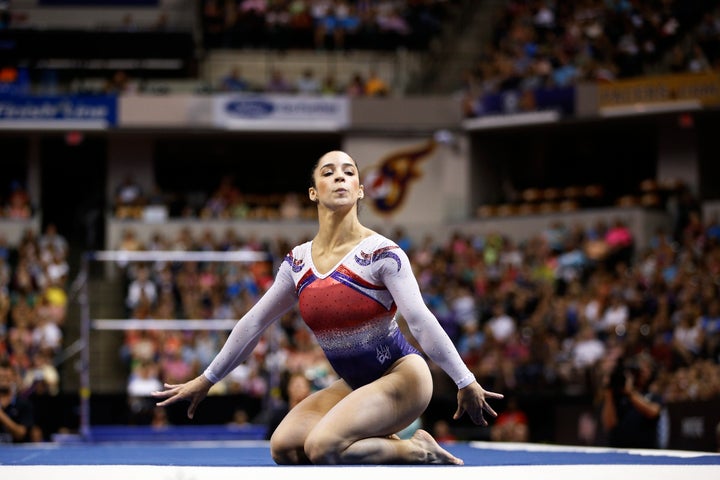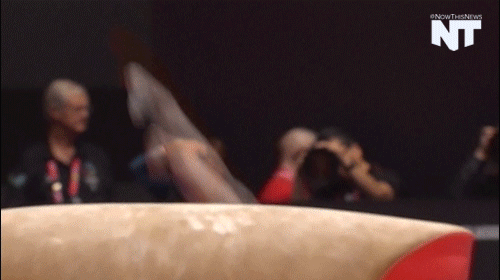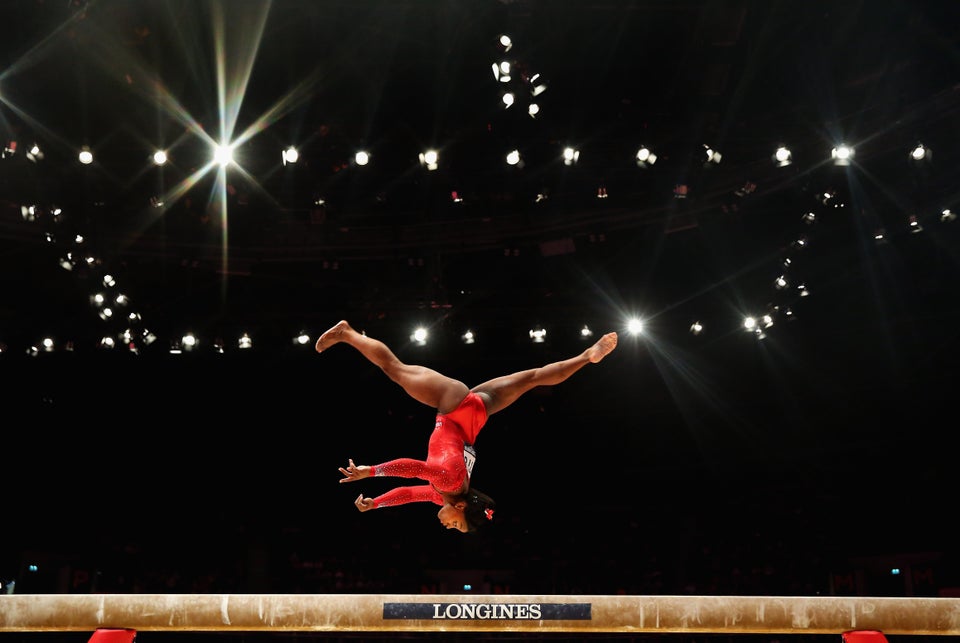
When you tune in to watch Olympic gymnastics this month, you should be prepared to see a lot of crystals, a lot of eyeliner, a lot of slow-motion fluff shots of hands over chalk buckets — and, of course, a lot of mind-blowing acrobatics. What you won’t see is a single perfect 10 score.
That’s because, as commentators will no doubt remind viewers when the gymnastics events begin on Sunday, the iconic perfect 10 is no more. Well, kind of. Gymnasts now get two scores: one for degree of difficulty, which is technically limitless but at the moment is rarely higher than 6.5, and one for execution, which is, in fact, out of 10. This means that if you do a routine with a difficulty score of 6.5 and perform it perfectly, you’ll walk away with a 16.5. Since the new scoring system was implemented in 2006, though, no gymnast has been awarded an execution score (or E-score) of 10.
The perfect 10 used to be elusive, but obtainable. For the last 10 years, it’s been unheard of.

In her new book The End of the Perfect 10: The Making and Breaking of Gymnastics’ Top Score — From Nadia to Now, gymnastics journalist Dvora Meyers explains how one of the most significant rule changes in gymnastics history happened — and how the implementation of the new scoring system created a golden opportunity for American gymnasts to take over global gymnastics.
The first woman to receive a perfect 10 was Nadia Comaneci, the Romanian phenom who created a sensation at the 1976 Games in Montreal; she didn’t just get the first perfect 10, she got 7 of them in one competition.
But in the 30 years that followed, gymnastics changed, a lot. Lots more people started being awarded 10s for execution, and as innovators in the sport started attempting more difficult tricks — not always performed perfectly — there was no way to reward them for moving the sport forward. What’s more valuable: an easy routine performed cleanly, or a harder routine performed with minor imperfections? The perfect 10 system incentivized the former, and, in a sense, punished gymnasts for attempting more difficult routines. Gymnastics had a scoring system that made sense to viewers — the closer you are to 10, the “better” the routine is — but that stifled innovation and encouraged athletes to play it safe. And, as more and more gymnasts began to hit their heads on the score’s ceiling, medal rankings were being determined by tiny fractions: a 9.91 puts a gold around your neck, but a 9.87 puts you back in fifth place.
Clearly, something had to change.
As Meyers explains, the new system took decades to go from pipe dream to law of the gym land, and it was controversial — there are still lots of people, some of them with a lot of clout in the gym world, who want to go back to the old way of doing things. But that seems unlikely, in part because, under the new open-ended scoring system, American gymnasts are dominating.

One of the major objections to the new open-ended system was, and still is, that it’s less marketable than the iconic perfect 10. It’s harder for viewers to understand, this argument goes, and they’ll find the sport less thrilling to watch if they can’t understand how close the gymnast they just watched came to perfection.
And while it’s true that viewership of gymnastics has dropped since the new system came into effect, there are lots of other factors contributing to that: there are more women’s sports to watch, including less traditional ones like the X-Games. But because gymnastics only gets mainstream attention in Olympic years, open-ended system skeptics “really get nervous with this idea of lay viewers or newcomers being confused, and attribute any loss of audience to the lack of comprehensibility in the sport,” Meyers said.

That said, the new system is not all that hard to understand, especially if broadcasters make the effort to show both the D-score and the E-score, the latter of which is, after all, still out of 10. Meyers said that part of the appeal of the old 10 was that it provided a frame of reference, a standard metric and a sense of orientation that has been somewhat lost by the introduction of theoretically limitless scoring.
And, she said, the longing for the perfect 10 is partly rooted in nostalgia: when people think about the 10, they think about Nadia, and about Mary Lou Retton, whose own 10 helped her become the first American woman to win all-around Olympic gold, at the 1984 Los Angeles Games. That win came at an important moment in the Cold War and in a sport traditionally dominated by Soviets, on American soil — “there’s so much more than just that particular 10,” Meyers said. “I think a lot of this is nostalgia for when gymnastics seemed to occupy a more central place in the culture, or at least in the Olympics, and things seemed to be going better for the sport.” But women’s gymnastics, she pointed out, is “probably as popular as it’s ever been” in the U.S., especially since an American woman has now won all-around gold at 3 consecutive games.
That’s a trend that only looks set to continue, with prodigy and three-time World Champion Simone Biles heavily favored to win a neckful of gold medals in Rio. Meyers argued that the new scoring system, which is officially called the Code of Points (“the Code” for short) seems to have envisioned a gymnast just like Biles. “The teenage Texan,” Meyers writes of Biles, “is a once-in-a-lifetime sort of gymnast, the kind of athlete that supporters of open-ended scoring must have had in mind … She is preternaturally talented. She can do heretofore-unthinkable skills cleanly. The Code, with its ‘sky’s the limit’ tolerance for difficulty, incentivizes Biles’s daredevil brand of gymnastics.”

Biles is unique; she is arguably the greatest gymnast of all time, and possibly one of the greatest athletes of any kind. But she’s not the only American who’s benefited from the new system. The new Code rewards strength and speed, and with a well-financed, semi-centralized training system (and lots of coaches from Romania and China), American gymnastics has produced not only three consecutive Olympic all-around champions, but a team gold in London and a team silver in Beijing, a sackful of World Championship team medals, and a remarkably deep bench; the U.S. women’s Olympic gymnastics team is one of the hardest teams in the world to make. Meyers notes that some of the fiercest opposition to the new Code of Points came from Americans, but it turns out that they’ve benefitted enormously from its implementation.
Despite that initial resistance, though, the new Code is here, and despite the lingering opposition, it’s probably not going anywhere. Under the new system, gymnastics has become more focused on tumbling and on gravity-defying vaults and dismounts; it’s explosive, and it’s thrilling, and while some of the dance elements of the floor exercise and balance beam have suffered, shoved aside in favour of ever more acrobatics, the sport is more athletic than ever. Spurred on by the promise of higher scores, the young women keep pushing their remarkable bodies further, and the sport keeps getting harder and more impressive.
As of this year, we’re 10 years in to a 10-less world, and, with Biles about to compete in Rio, about to witness the Olympic triumph of the Code’s ideal gymnast. We’re well and truly into the era of the open-ended score, where technically, there’s no ceiling to the number a gymnast can put on the board. Which is tremendously exciting; after all, to quote Hillary Clinton quoting Lil Wayne, when there’s no ceiling, the sky’s the limit.
For more Olympic coverage:

